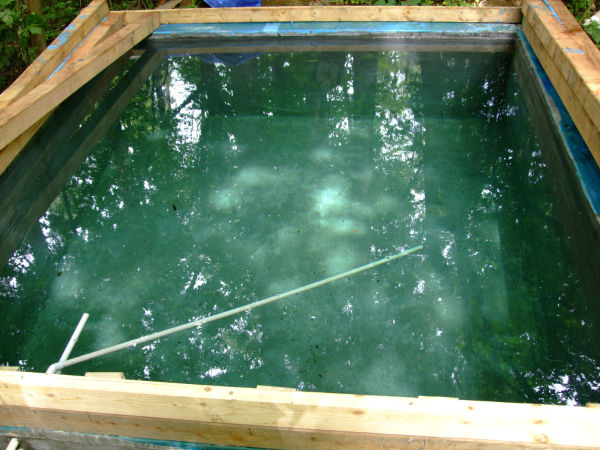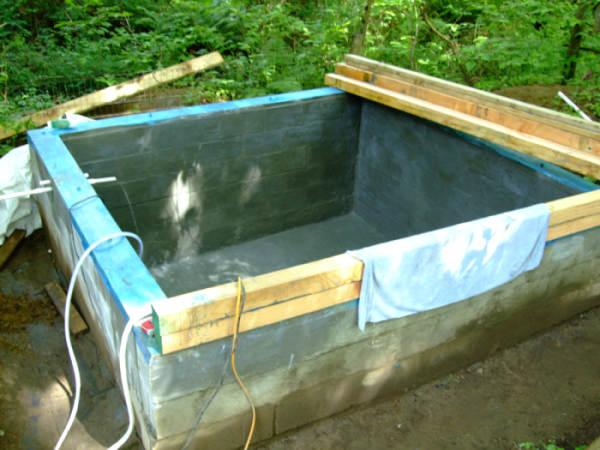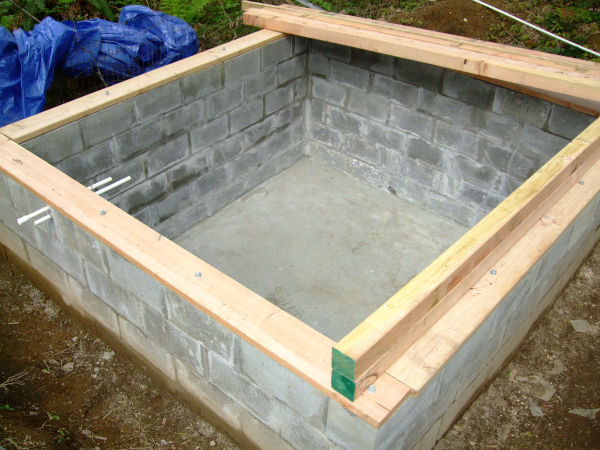
Links
Home
System overview
What to test for
Filter pictures
Water clarity
First flush diverter
> 2500 gallon cistern
About this website
Water Test Results
Conditions of Use
PDF Version
External links
Slow sand filter FAQ
Home
System overview
What to test for
Filter pictures
Water clarity
First flush diverter
> 2500 gallon cistern
About this website
Water Test Results
Conditions of Use
PDF Version
External links
Slow sand filter FAQ
2500 gallon Concrete Block Cistern
|
Please help support this site by purchasing, for $7.50, a summary of the most important results of our research for the past 8 years, including detailed drawings of the filters. This page on our blog has the purchase area. Thank you!! |
The blocks are concrete (not pumice) and are filled with concrete and reinforced with 1/2 inch rebar. The bottom is a 5 inch thick concrete pad. This cistern is sealed on the inside with potable water approved portland cement. Made by: Ash Grove Cement Company, 11011 Cody Street Suite 125 Overland Park, KS 66210, United States. 913-722-5998. The local supplier of that product is Mutual Materials. The cement is mixed with water (no sand added) to form a thick paste and then applied like paint with a brush. It sets up in about 12 - 14 hours, then the next coat can be applied. Once the concrete is set, water will not hurt it as long as the temperature is above freezing. I would recommend also sealing the outside surface in the same manner. Leaks, on the outside only can be quickly stopped with rapid setting concrete.
Actually, concrete (cement) - portland cement - will harden underwater because it does not "dry", it hardens due to reaction with water. It must set up first, however. This cistern has 2 coats of portland cement which is not enough. At least 6 coats are recommended. The cistern looses about 50 gallons a week at maximum capacity - less as the water level lowers.
As of March 23, 2013, there has been no measureable leakage since the extra coats of cement were applied in May of 2011.
As of May 2011, 4 more coats of cement were added to the inside of the walls, and 6 coats added at the corners. This stopped the gradual leaking.
As of September 13, 2010 there are 1900 gallons left in the cistern. Approximately 250 gallons have been used. The seepage has slowed down considerably to barely noticable. There are potable water approved custom sized plastic inserts available from Ameri-brand pool and spa
When the cistern is full; it holds over 20,000 pounds of water. Water weighs about 8.34 pounds per gallon: 8.34 X 2500 = 20850 pounds. Divide that by 2000 and we get 10 tons. If you build a cistern be absolutely certain it can withstand lots of weight and pressure. This one was purposely over-built and placed partially underground to hold the weight of the water and to keep it cool in the summer.
This is the cistern without the removable roofing. It is full of filtered water. The green color is from the color of the cement and reflections from the big leaf maple trees above. The water is 49 inches deep. The cistern is 10 feet long by 9 feet wide. The roofing (not shown here) keeps algae from growing in the water by blocking out sunlight. The cover is not shown, but is tight enough to keep out small (and large) mammals and insects.

Below is the cistern just before starting to fill.

Below is the cistern after the cement has been wire-brushed to allow even coating of the portland cement sealer.

creative commons attribution share alike license.